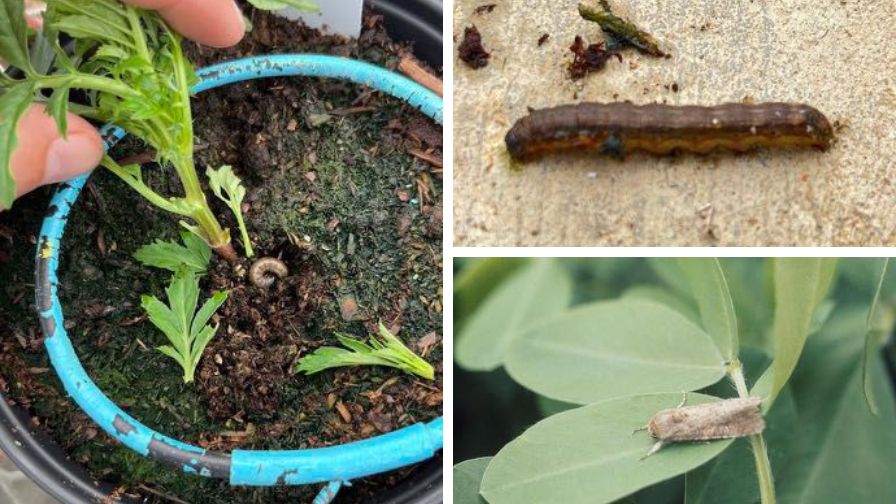
(Clockwise from left) A fall armyworm burrowed into substrate, a brown fall armyworm, and an adult fall armyworm on a plant | Patrick Veazie, John C. French, Jr., Universities: Auburn, Georgia, Clemson and
Missouri (retired), Bugwood.org
While more common as a persistent pest among landscaping and turfgrass, fall armyworms (Spodoptera frugiperda) can still find their way into greenhouse environments. When and if they do, growers can expect extensive damage to their crops.
In the same way that W. Garrett Owen of The Ohio State University examined how to deal with unwanted slug infestations damaging seasonal poinsettia plants in a previous e-Gro Alert, Brian E. Whipker and Patrick Veazie of North Carolina State University now look at how greenhouse growers can protect their marigolds from fall armyworms.
Signs and Identification of Fall Armyworms in Greenhouses
Signs of damage as a result of fall armyworms can be difficult to determine.
Writes Whipker, “When inspecting our greenhouses, tattered foliage accompanied by frass was observed on several plants. However, upon closer investigation, the feeding damage was more prevalent on the lower foliage, and in some cases, the entire axillary shoots were removed, but no insects were located on the foliage.”
Further inspection into the top strata of the substrate revealed fall armyworms, but, if left alone for long enough, the worms can burrow deep into the substrate, making it very difficult to identify their presence, and therefore find out the cause of the damage.
Migratory from “Southern Florida, South Texas, or Mexico,” hence their common appearance during the fall season, greenhouse environments offer a perfect place for fall armyworm larvae, regarding both climate and an abundance of food.
According to Whipker and Veazie, “Fall armyworms can be observed in various colors ranging from light brown to almost black and can grow up to 1.5 inches long. One key identifier is an inverted “Y” located on the top of the head. Adults are 1.25 to 1.5 inches long. They can be confused with cutworms and more in-depth inspection by a diagnostic clinic is needed to determine the species.”
Pest Management Prevention and Treatment Strategies for Fall Armyworms
The control method for fall armyworms is simple. Growers and operation staff should regularly “be on the lookout for abnormal lower leaf defoliation.” Proper, timely, and thorough insect screens should be paired with methods to limit pest entrance points.
Lastly, applications “including neem oil and pyrethroids” are found to be useful. Chemical control is also an option but is most effective “when insects are less developed.”
For more information regarding pest control and prevention methods for fall armyworms, please read the full e-Gro (Electronic Grower Resources Online) Alert “Don’t Let Fall Armyworms Cut into Fall Profits.” Additional and current e-Gro Alert pieces from Volume 13 (2024) can be found online.

